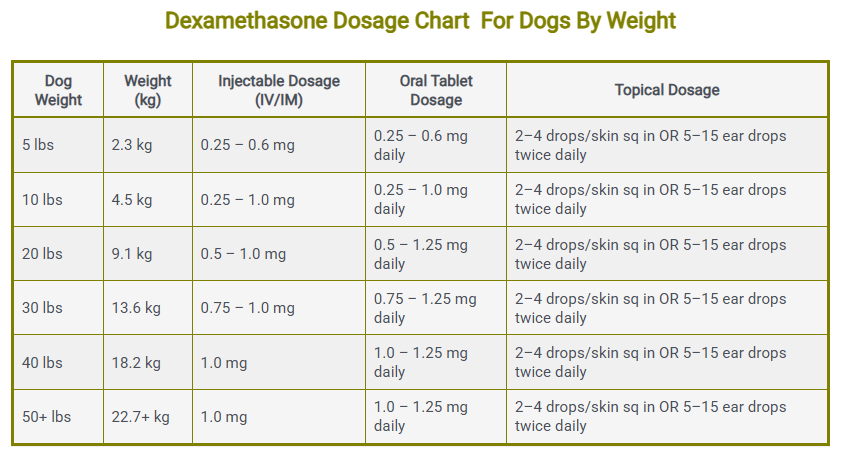Dexamethasone is a synthetic corticosteroid that mimics the action of cortisol—a natural hormone produced by the adrenal glands. It’s widely used in both human and veterinary medicine for its powerful anti-inflammatory and immunosuppressive properties. When your dog is suffering from inflammation, allergies, or autoimmune disorders, dexamethasone can be a game-changer. This medication is especially potent, making it ideal for acute situations where immediate relief is critical.
Unlike some other medications, dexamethasone works by altering the immune system’s response, essentially “dialing down” the inflammation and pain signals. It’s available in various forms: oral tablets, injectable solutions, and even eye or ear drops. But it’s not a casual remedy. Dexamethasone needs to be dosed correctly and carefully managed to avoid side effects.
This guide will cover all about Dexamethasone for dogs, its dosage, dosage chart, benefits, side effects, and more.
Dexamethasone Dosage For Dogs
The appropriate dexamethasone dosage for dogs depends on the form of administration and condition being treated. Injectable dexamethasone (2 mg/ml) or dexamethasone sodium phosphate (4.0 mg/ml, equals 3 mg dexamethasone) can be given intravenously or intramuscularly at 0.25 to 1 mg, repeatable for 3 to 5 days.
Oral tablets are prescribed at 0.25 to 1.25 mg daily for up to 7 days, with chewable tablets optionally divided between meals. Once a response is noted, reduce the dose by 0.125 mg daily to reach a maintenance dose.
Topically, apply 2–4 drops per square inch (skin) or 5–15 drops in the ear twice daily for no more than 7 days. Always use under veterinary guidance.
Dexamethasone Dosage Chart For Dogs By Weight
| Dog Weight | Weight (kg) | Injectable Dosage (IV/IM) | Oral Tablet Dosage | Topical Dosage |
|---|---|---|---|---|
| 5 lbs | 2.3 kg | 0.25 – 0.6 mg | 0.25 – 0.6 mg daily | 2–4 drops/skin sq in OR 5–15 ear drops twice daily |
| 10 lbs | 4.5 kg | 0.25 – 1.0 mg | 0.25 – 1.0 mg daily | 2–4 drops/skin sq in OR 5–15 ear drops twice daily |
| 20 lbs | 9.1 kg | 0.5 – 1.0 mg | 0.5 – 1.25 mg daily | 2–4 drops/skin sq in OR 5–15 ear drops twice daily |
| 30 lbs | 13.6 kg | 0.75 – 1.0 mg | 0.75 – 1.25 mg daily | 2–4 drops/skin sq in OR 5–15 ear drops twice daily |
| 40 lbs | 18.2 kg | 1.0 mg | 1.0 – 1.25 mg daily | 2–4 drops/skin sq in OR 5–15 ear drops twice daily |
| 50+ lbs | 22.7+ kg | 1.0 mg | 1.0 – 1.25 mg daily | 2–4 drops/skin sq in OR 5–15 ear drops twice daily |
How Dexamethasone Works in Dogs
Dexamethasone works at the cellular level by entering cells and binding to specific receptors that influence the expression of anti-inflammatory genes while suppressing pro-inflammatory ones. What does this mean for your dog? Less swelling, reduced redness, and lower pain levels almost immediately after administration. It also decreases the production of substances like histamines and prostaglandins that drive allergic reactions and inflammation.
This steroid also helps manage conditions where the dog’s immune system is attacking itself, such as autoimmune skin diseases or hemolytic anemia. It’s like hitting a reset button on an overactive immune system.
For acute issues like spinal cord trauma or severe allergies, a high “shock dose” of dexamethasone may be given to rapidly control the inflammation. In contrast, for chronic conditions like arthritis or inflammatory bowel disease (IBD), lower, sustained doses are used over longer periods.
Common Conditions Treated With Dexamethasone
Dexamethasone is incredibly versatile. Vets often prescribe it for:
- Allergic reactions, including insect bites or food allergies
- Asthma and other respiratory issues
- Autoimmune diseases like lupus or pemphigus
- Inflammatory bowel disease (IBD)
- Arthritis and joint pain
- Brain swelling due to trauma or tumors
- Spinal cord compression
- Certain types of cancer treatment plans
Its quick action and effectiveness make it a go-to drug in veterinary emergencies. However, it’s not a one-size-fits-all solution, and that’s why knowing the correct dosage based on your dog’s weight is critical.
Benefits of Dexamethasone for Dogs
Fast-Acting Relief for Inflammation
When a canines is in visible discomfort—swollen joints, itching skin, difficulty breathing—time is of the essence. Dexamethasone for dogs acts faster than many other steroids, often kicking in within hours. That’s crucial in emergencies where every minute counts, like a severe allergic reaction or post-surgery inflammation.
The reduction in inflammation also aids in improving mobility, especially in senior dogs who suffer from chronic conditions like arthritis. Once inflammation is under control, your dog can move more comfortably, eat better, and generally regain its usual happy demeanor.
Emergency Use in Allergic Reactions or Shock
Vets often rely on dexamethasone in high-stress emergency settings. For example, if your furry friend is experiencing anaphylactic shock from a bee sting or an adverse vaccine reaction, dexamethasone can help stabilize them quickly. It helps prevent the swelling of airways and reduces systemic shock symptoms, buying time for further treatment.
In trauma cases, such as being hit by a car or suffering a spinal injury, dexamethasone is used to prevent swelling in the brain or spinal cord. Its ability to cross the blood-brain barrier and act on central nervous tissues is another reason it’s favored in neurological emergencies.
Managing Autoimmune and Chronic Conditions
Chronic conditions like lupus, IBD, or even some cancers require long-term management. Dexamethasone offers a way to suppress inappropriate immune responses without relying on harsh chemotherapy drugs or invasive surgeries. In these cases, the dosage is carefully tapered and adjusted over time to balance efficacy with safety.
Dogs with chronic skin allergies or autoimmune skin diseases may find relief after a long struggle with other medications. The reduced inflammation also helps heal wounds faster, prevents infection, and generally improves skin health.
Dexamethasone Dosage Guidelines
Factors Affecting Dosage
When it comes to giving your dog dexamethasone, one size definitely doesn’t fit all. Dosage can vary widely depending on a variety of factors. These include:
- Your dog’s weight – The heavier the dog, the higher the dose (usually measured in mg/kg).
- The condition being treated – Acute conditions like shock or trauma may require higher doses than chronic conditions like arthritis or allergies.
- Mode of administration – Oral tablets might require different dosages compared to injectable forms due to absorption rates.
- Duration of treatment – Short-term treatment typically involves higher doses for a shorter period, whereas long-term treatment requires a gradual tapering.
- Overall health and medical history – Dogs with liver, kidney, or heart conditions may need adjusted doses.
A skilled veterinarian will consider all these factors before prescribing the exact dosage. That’s why self-diagnosing or adjusting the dose without veterinary input is risky.
Dosage Frequency and Duration
Dexamethasone can be prescribed for:
- Once a day for acute issues
- Every other day for long-term, chronic conditions
- Single high-dose injection in emergency cases
For short-term problems like allergic reactions or post-surgery inflammation, your furry friend might only need a few doses over a week. Chronic cases, however, often require tapering to reduce dependency and prevent adrenal gland shutdown.
A common tapering schedule might look like:
- High dose for 3–5 days
- Medium dose for the next 5–7 days
- Low dose every other day for 2 weeks
- Then discontinuation, depending on the condition’s response
Skipping tapering can lead to withdrawal symptoms such as vomiting, weakness, or even collapse due to adrenal insufficiency. That’s why vets often schedule follow-up visits to reassess and adjust the dosage as needed.
How to Administer Dexamethasone to Dogs
Oral Tablets vs. Injections
Administering dog dexamethasone comes down to two primary forms: oral tablets and injectable solutions. Each method has its own set of pros and cons depending on your dog’s condition, the urgency of the situation, and how cooperative your dog is.
Oral Tablets: These are the most common and convenient for at-home treatment. Doses can be easily adjusted and split. Tablets usually come in strengths like 0.25 mg, 0.5 mg, and 1 mg. For chronic issues like arthritis or IBD, tablets allow long-term management and tapering.
Injectable Form: Administered by a veterinarian or trained owner, injections deliver dexamethasone directly into the bloodstream or muscle for rapid absorption. This form is typically used for emergency situations, like shock or brain swelling.
When to Use Which?
- Oral: Ideal for long-term or mild conditions
- Injection: Best for emergencies, hospital settings, or when a dog can’t take pills due to vomiting
Veterinary Tip: If your dog is vomiting, never give oral dexamethasone. It won’t absorb properly and can worsen GI symptoms. Injections bypass the digestive tract and act faster.
Tips for Giving Oral Medication
Getting a dog to take medicine can be a battle. Here are a few pet-owner-approved hacks:
- Pill pockets: These are treats with a hollow center, perfect for hiding tablets
- Peanut butter or cheese: Smear a bit around the pill to mask the taste
- Crush and mix: If your dog is super fussy, ask the vet if the tablet can be crushed and mixed with food
- Syringe method: Some vets provide dexamethasone in liquid form, which can be squirted directly into the mouth with a syringe
Important: Always wash your hands after handling steroids. And never use human dexamethasone or adjust the dosage without guidance.
Monitoring for Effectiveness
You can’t always tell immediately if a medication is working, but dexamethasone tends to show noticeable effects within 24 to 48 hours. Here’s what to look for:
- Decreased inflammation: Swelling, redness, or heat should start subsiding
- Improved energy: Dogs may be more playful or move easier if inflammation is controlled
- Appetite changes: Dexamethasone often increases hunger and thirst
- Allergy relief: Less itching, sneezing, or ear scratching
Red flags to watch for:
- Excessive thirst and urination
- Lethargy, vomiting, or diarrhea
- Behavioral changes like restlessness or aggression
Keep a medication journal—recording dosages, timing, and any noticeable effects helps your vet fine-tune the treatment plan.
Side Effects of Dexamethasone in Dogs
Short-Term Side Effects
Even a few days on dexamethasone can trigger noticeable changes in your dog. Common short-term side effects include:
- Increased thirst and urination: This is due to hormonal shifts triggered by the steroid
- Increased appetite: You might notice your dog raiding the trash or begging for food
- Panting or restlessness: This is a known reaction, especially in larger breeds
- Upset stomach: Vomiting, diarrhea, or soft stools can happen, particularly if given on an empty stomach
These effects are generally manageable and temporary. Providing plenty of water and feeding meals at consistent times can help.
Quick Tip: If your pup starts drinking excessively, you may need more frequent potty breaks. Accidents in the house can happen, so plan accordingly during treatment.
Long-Term Risks
Dexamethasone is not a drug you want to use long-term unless absolutely necessary. Prolonged use can lead to:
- Cushing’s disease (hyperadrenocorticism): The body starts overproducing cortisol due to feedback disruption
- Adrenal suppression: The adrenal glands may shut down if steroids are suddenly stopped
- Muscle wasting and weakness: Long-term exposure can break down muscle tissue
- Liver enlargement and dysfunction: Regular blood work is a must if your dog is on steroids for months
- Delayed wound healing: Steroids can suppress the immune system, slowing recovery from cuts or infections
Vets usually recommend “pulse dosing” or alternate-day schedules for long-term treatments to reduce these risks.
When to Contact a Vet
Some side effects are emergencies and need immediate veterinary attention:
- Bloody stools or vomiting blood
- Collapse or unresponsiveness
- Signs of infection (fever, oozing wounds, coughing)
- Sudden changes in behavior or appetite
Also, never stop dexamethasone cold turkey. The dosage must be tapered over time to avoid adrenal crisis—a condition that can be fatal.
Warnings and Precautions
Not all dogs should receive dexamethasone. This steroid is contraindicated in the following cases:
- Dogs with fungal infections: Dexamethasone suppresses the immune system, worsening the infection
- Puppies under 6 months: Their immune systems and growth plates are still developing
- Dogs with diabetes: It spikes blood sugar and can destabilize diabetic canines
- Dogs already on NSAIDs (like Rimadyl): Combining increases risk of GI ulcers and bleeding
Always inform your vet about all medications and underlying conditions before starting steroid therapy.
Drug Interactions to Watch For
Dexamethasone interacts with several common medications:
- Non-steroidal anti-inflammatory drugs (NSAIDs): Increased risk of gastrointestinal ulcers and bleeding
- Diuretics: Can cause electrolyte imbalances
- Insulin: May require dose adjustments in diabetic dogs
- Vaccines: Live vaccines should not be administered during steroid treatment
Even over-the-counter supplements can clash with dexamethasone. Let your vet know about everything your dog is taking, even if it’s “natural.”
Use in Pregnant or Senior Dogs
Pregnancy and age complicate steroid use:
- Pregnant dogs: Dexamethasone can induce labor or harm fetal development, especially during the last trimester
- Senior dogs: Older dogs are more prone to side effects like liver strain, muscle loss, or kidney stress
If steroids are essential for treatment in these sensitive groups, your vet will likely use the lowest possible dose for the shortest time and monitor closely.
Importance of Tapering the Dose
One of the most critical steps in dexamethasone therapy is the tapering process—gradually reducing the dosage rather than stopping abruptly. Why? Because dexamethasone suppresses your dog’s natural cortisol production. If stopped suddenly, your dog’s body might not be able to produce enough cortisol on its own, leading to a potentially fatal condition known as adrenal insufficiency.
Tapering gives your dog’s adrenal glands time to “wake back up” and resume natural hormone production. Even after short-term use (as little as 7 days), tapering may still be required.
Signs your dog may be at risk if the dose isn’t tapered:
- Weakness or lethargy
- Vomiting or diarrhea
- Low blood pressure or collapse
- Loss of appetite
Always follow the tapering schedule prescribed by your vet. If any withdrawal symptoms appear, seek emergency veterinary care immediately.
Alternatives to Dexamethasone
Natural Anti-Inflammatory Options
If you’re hesitant about long-term steroid use—or your dog is sensitive to side effects—natural alternatives might be worth exploring. While not as potent as dexamethasone, these options can help manage mild to moderate inflammation:
- Omega-3 fatty acids (from fish oil): Reduces joint inflammation
- Turmeric (curcumin): Natural anti-inflammatory, often included in dog-safe supplements
- CBD oil: Anecdotally helps with pain, anxiety, and inflammation
- Boswellia serrata: Used in herbal medicine for arthritis and joint support
These options are generally safer for long-term use but should still be discussed with your vet before starting. They might interact with other meds or require specific dosages.
Other Prescription Steroids
Sometimes dexamethasone may not be the best fit, and other corticosteroids are considered:
- Prednisone/Prednisolone: More commonly prescribed and often used for moderate inflammatory conditions
- Triamcinolone: Intermediate-acting steroid for skin conditions
- Hydrocortisone: Often found in topical creams
While these alternatives may be gentler or better tolerated by your dog, they still come with similar side effects and require proper dosage management.
| Steroid | Potency (Compared to Dexamethasone) | Duration | Common Use |
|---|---|---|---|
| Prednisone | ~1/7 of Dexamethasone | Intermediate | Chronic inflammation, allergies |
| Triamcinolone | ~1/5 of Dexamethasone | Intermediate | Skin, joint, or ear issues |
| Hydrocortisone | ~1/25 of Dexamethasone | Short-acting | Topical creams, mild skin issues |
Final Thoughts
Dexamethasone can be a lifesaver for dogs dealing with everything from allergic reactions to autoimmune disorders and severe inflammation. Its powerful anti-inflammatory and immunosuppressive properties make it a go-to solution in both emergency and long-term care settings. But with great power comes great responsibility.
Getting the correct dosage by weight, understanding when and how to administer it, and being mindful of short-term and long-term side effects are all crucial.
Whether you’re treating a one-time allergic reaction or managing a chronic illness, the key is close collaboration with your veterinarian. Proper monitoring, gradual tapering, and exploring natural or prescription alternatives can help ensure your dog gets the relief they need without unnecessary risk.
FAQs
Can I give my dog dexamethasone without a vet’s prescription?
No. Dexamethasone is a potent steroid that requires a vet’s supervision. Using it without guidance can lead to serious health issues like adrenal suppression, gastrointestinal bleeding, or even death.
What should I do if I miss a dose?
If you forget a dose, give it as soon as you remember. If it’s close to the next scheduled dose, skip the missed one—don’t double up. Contact your vet if you’re unsure.
How long does it take dexamethasone to work in dogs?
Most dogs begin showing improvement within 24 to 48 hours. Emergency cases like allergic shock can see results in minutes when given via injection.
Is dexamethasone safe for long-term use?
Not usually. Long-term use increases the risk of serious side effects like liver problems, Cushing’s disease, and immune suppression. It’s best for short-term or intermittent use unless otherwise directed by a vet.
What’s the difference between dexamethasone and prednisone for dogs?
Dexamethasone is significantly more potent—about 7-10 times stronger than prednisone. It works faster and is preferred in acute or emergency situations, whereas prednisone is often used for long-term management.











![Can Dogs Eat Blood? 7 Side Effects [Expert Opinion]](https://petskor.com/wp-content/uploads/2022/04/Webp.net-resizeimage-12.jpg)
